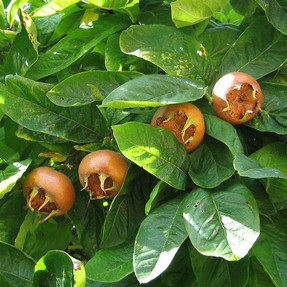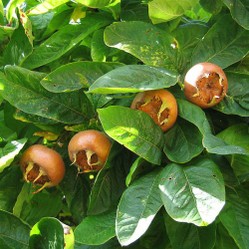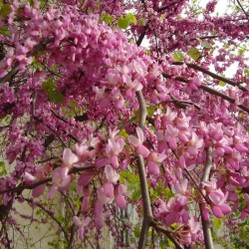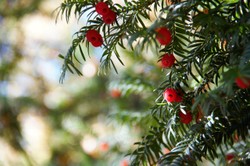I'd never heard of the Medlar tree until I happened to notice that the Local Authority had planted two new trees in a nearby park. Even then, I didn't know exactly what they were, or that they would eventually bear edible fruit.
Now, several years later, there's enough fruit on those two trees for me to take enough to make one of the recipes I've found for the Medlar fruit. But I won't be selfish, I'll leave enough on the trees for anyone else who might have the same idea.

The Medlar Tree - Fruit and Recipes
Have you ever heard of the Medlar tree? Did you know it bears edible fruit? What recipes are there for the Medlar fruit?
Identifying the Medlar Tree
 When I first saw these two trees in my local park, I was intrigued. The Local Authority had been planting some interesting trees on that small space in recent years, mainly Olive Trees and European Pines. I live in the East of England, and I know these trees are hardy enough to survive here, but it was interesting that they’d decided to start a Southern European theme. I wondered what these new trees were.
When I first saw these two trees in my local park, I was intrigued. The Local Authority had been planting some interesting trees on that small space in recent years, mainly Olive Trees and European Pines. I live in the East of England, and I know these trees are hardy enough to survive here, but it was interesting that they’d decided to start a Southern European theme. I wondered what these new trees were.
It was winter and there were no leaves. There were no labels or anything like that, so I was left guessing. In spring, new leaves appeared and small white flowers, like the Hawthorn but larger. It looked like it would grow into attractive tree, but it wasn’t until the fruit began to develop that I had my first real clue. They looked like giant Rosehips, and I waited until they were big enough, then picked one and took it home. After about half an hour of leafing through my copy of the A-Z Encyclopedia of Garden Plants, I discovered it was a Medlar tree. Then, the whole world of Medlars opened up to me.
The Medlar tree (Mespilus germanica) is a member of the Rosaceae family, and it’s native to south western Asia. It was cultivated in Europe for its handsome appearance and edible fruit, and became quite popular in Victorian times. Since then it’s fallen out of fashion and is now relatively unknown. The fruits themselves are not widely available in shops. They can be bought from farmers’ markets, allegedly, but I’ve never seen them. The best way to ensure a supply of Medlar fruit is to plant your own tree, or to find a park like mine.
(You can read about the A-Z Encyclopedia of Garden Plants, and why I recommend this as the best reference book for gardeners in both Britain and the US, on my article at Squidoo - Best in Gardening Books - The A-Z Encyclopedia of Garden Plants.)
Photograph © Andrew Dunn, 1 October 2005.
This file is licensed under the Creative Commons Attribution-Share Alike 2.0 Generic license.
The AHS A-Z Encyclopedia of Garden Plants
For American Gardeners
 | American Horticultural Society A to Z Encyclopedia of Garden Plants (The American Horticultural S... The most comprehensive, detailed, and lavishly illustrated guide to garden plants ever published, first published in 1997, has now been completely revised to include nearly 250 ... |
Discovering the Medlar Fruit
It’s taken a couple of seasons, but now there are enough fruits on those trees, without being too greedy, to think about making something with them. I’ve learned that you can eat them raw, though it’s an acquired taste. I have tried one that I picked in September, and it was very bitter, but I’ve also discovered that they need to undergo a process called bletting. This happens naturally when the fruits have had their first frost. The fruit sugars increase and the tannins decrease. Cooking with added sugar should also help.
The recipe I’ve decided to make is Walnut Bakewell Tart with Roasted Medlars by James Martin from BBC Saturday Kitchen. You can also make Medlar Jelly, but we’ll see how we get on with the Bakewell Tart first. It’s now nearly October, and the fruits won’t be ready for a few weeks. I’ll come back and let you know how I get on later in the year. I only hope nobody else discovers ‘my’ Medlar trees before then.
There are some useful links below, including the recipe I plan to make by James Martin.
Some useful links on Medlars and their fruit
Medlar trees, medlar fruit and recipes
You might also like
The Judas Tree - or Love TreeThis tree is commonly known as the Judas Tree, and less commonly known as the...
A Tree Sacred and DeadlyAncient people's regarded yew trees as magical or sacred, but they often used...
The British OakOak trees are inextricably linked with Britishness, for if there is a nationa...



 How to Make Pork Cracklingon 12/29/2012
How to Make Pork Cracklingon 12/29/2012
 What is a Sustainable Fish?on 11/23/2012
What is a Sustainable Fish?on 11/23/2012
 Red Kites in Britain - a Remarkable Comebackon 09/30/2012
Red Kites in Britain - a Remarkable Comebackon 09/30/2012
 Britain's White-tailed Eagles - Extinction and Recoveryon 09/29/2012
Britain's White-tailed Eagles - Extinction and Recoveryon 09/29/2012




Has this page been useful to you?
In Britian medlars are more common in the south than elsewhere, but I did see some in North West England, when walking in old parkland. They were in an old hedge.
I moved to Cyprus and Medlar trees are very common. when picked at the ripe stage, the fruit is yellow and edible. The local birds just love this fruit! It is difficult to get to any of the fruit before they do. Now I have found out about them from you, I will give the "cheese" a try and let you know.
I found this page through lensroll.com while I was posting a couple of my pages there. This is the first time I've been to a wizzley page. Very nice.
Do let us know how you got on :) I have never had medlars.
Ragtimelil and Sheri - I'm not aware I've seen more than these two trees, and I wouldn't have heard of them otherwise.
Mira - Later in the month I might be able to tell you more about the taste. They taste really bitter at the moment because there's been no frost. There are other fruits that increase in sugar with cold weather. The Blackthorn fruit, or Sloe, is one example. Useful to know if you're planning on making Sloe Gin.
2uesday - they're part of the Rosaceae family which includes roses, so that's probably the reason though the same family also includes plums, cherries and almonds.
Is this a sweeter version of quince, by any chance? I imagine it between quince and kumquat myself :-) Interesting what you say, that the sugars increase on the first frost!
Never heard of this tree. Interesting.
I'd love to try it but haven't seen any of these around. Interesting article!